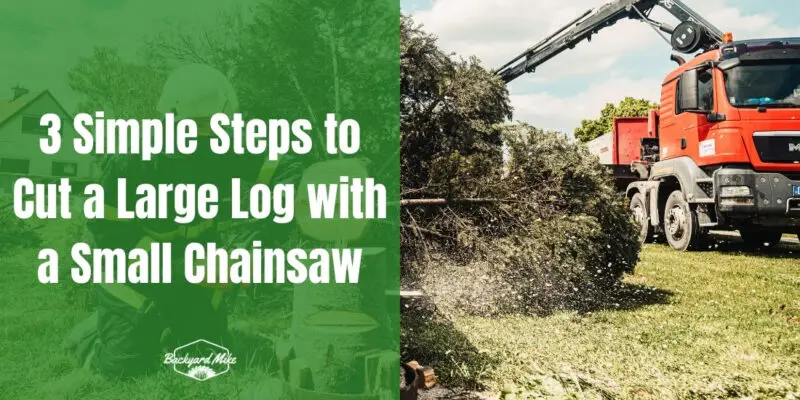First, prepare your workspace by ensuring the ground is stable and clear of obstacles. Secure logs firmly to prevent movement. Next, execute proper cutting techniques by keeping the chainsaw bar parallel to the ground, using wedges to prevent binding, and maintaining a consistent line. Finally, focus on safe handling and cleanup by wearing protective gear, clearing debris, and organizing logs. Explore further for more in-depth guidance on effectively using a small chainsaw.
Key Takeaways
- Secure the log firmly to prevent movement during cutting.
- Use wedges to keep the cut open and reduce binding risk.
- Begin by making an undercut from the underside of the log.
- Complete the cut with an overbucking technique from the top.
- Consistently sharpen the chainsaw for efficient and safe operation.
Assess and Prepare the Workspace
Before you begin cutting, it's vital to assess and prepare your workspace for safety and efficiency. Start by choosing a clear area for your workspace layout, guaranteeing there's enough room for maneuverability. Check the ground stability; it should be level to prevent logs from rolling. If the ground is uneven, use materials like plywood or metal plates to create a stable surface. Remove any obstacles that could hinder your movement or cause tripping hazards. Adequate lighting is essential for visibility, so verify your workspace is well-lit. Secure logs firmly in place with chains, clamps, or log dogs to ensure they don't move during cutting.
Execute Proper Cutting Techniques
Begin your cutting process by mastering the essential techniques needed for effective and safe chainsaw use. Keep the chainsaw bar parallel to the ground and verify the guide bar nose doesn't contact the surface, maintaining chainsaw safety. When overbucking large logs, start from the top, confirming the log support is solid. Apply gentle pressure, allowing the chainsaw to naturally pull into the log. Remember to stay on your buck and maintain a consistent cutting line to avoid double bucking. For underbucking, begin from the underside, cutting about one-third in, then finish the cut from the top. When handling large logs with small bars, begin at the smaller end, rotating the bar as needed. Use wedges to prevent binding. Make sure to consider chainsaw safety features such as trigger locks and anti-vibration systems to reduce the risk of accidents. Finally, in plunge cutting, identify tension areas, cut from the bottom half, and maintain firm control.
Ensure Safe Handling and Cleanup
When ensuring safe handling and cleanup in your chainsaw operations, always start by preparing the environment. Clear the area of debris and obstacles, ensuring stable footing to prevent slips. Check for hazards like widow makers and mark incomplete cuts for safety. Set up escape routes for emergencies. Use safety equipment consistently: wear full-face shields, ear protection, hard hats, leather gloves, and safety boots. For kickback management, avoid tip contact, stay alert, maintain a firm grip, and keep the saw on stable material. Chainsaw chaps, which are an essential protective gear, should also be worn to protect against serious injuries. After cutting, remove debris, organize logs, and verify the area's safety. Bucking refers to cutting a fallen tree to the desired length, and it is essential to follow proper techniques for effective and safe logging. Clean and store your tools properly, and monitor fatigue to stay safe. Following these steps fosters a sense of safety and belonging in your work.
Frequently Asked Questions
How Do I Sharpen a Chainsaw Chain Effectively?
Sharpen your chainsaw chain effectively by securing it, marking a guide tooth, and filing at a consistent angle. Rotate the file regularly. After sharpening, inspect and adjust the depth limiter, and guarantee proper chain lubrication for ideal chainsaw maintenance.
What Safety Gear Is Essential for Chainsaw Use?
You're braving a chainsaw, a roaring beast of power! You need chainsaw gloves that could stop a speeding bullet and a protective helmet tougher than a knight's armor. This gear unites us in safety, a community of chainsaw warriors.
How Can I Stabilize an Uneven Log Before Cutting?
To stabilize an uneven log, use log stabilization techniques by placing blocks or wedges under it. Employ uneven surface solutions like leveling jigs. This approach guarantees community safety while cutting, making you feel part of a skilled group.
What Is the Best Way to Prevent Chainsaw Kickback?
To guarantee chainsaw safety and kickback prevention, always maintain a firm grip, use a chain brake, and avoid the bar's tip. Regularly check your saw's condition and wear protective gear. Stay focused and take frequent breaks together.
How Do I Determine the Correct Chain Tension for My Chainsaw?
A stitch in time saves nine, so guarantee your chain tension is spot-on. Use snap and pull tests or adjustment techniques to find the sweet spot. You'll be part of the safe and efficient chainsaw community!
Conclusion
You've now mastered the method to manage large logs with a small chainsaw. First, focus on finding a flat, firm foundation to safely support your work. Next, navigate your cuts with care, ensuring each slice is smooth and steady. Finally, finish by following safe practices, securing a spotless space. These steps simplify the process, promoting precision and safety. Remember, preparation and proper technique are pivotal for proficiently processing timber. Practice patience, and you'll perfect the process.


